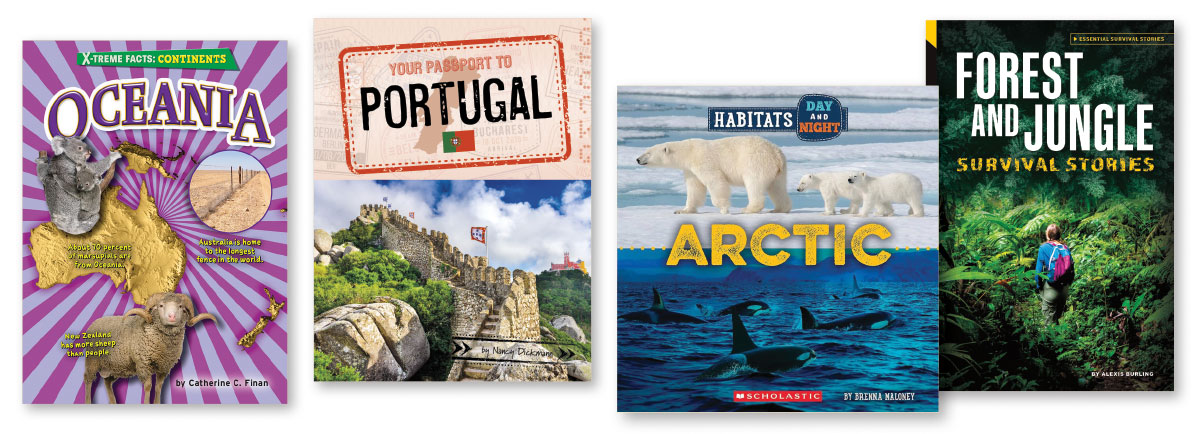Adventure Around the World | Geography Series Nonfiction
Familiar characters, harrowing survival stories, and regional fact guides help readers expand their knowledge about the world around them in this spring’s geography selections.
Several of the series reviewed below look at different levels of geographical divisions, from cities and regions to countries and continents. A few others utilize familiar television characters to introduce distinctive places from around the world and within communities. Another set explores the way environmental conditions, including time of day, impact the lives of animals. Geography isn’t always kind, though, as demonstrated in two new sets that examine the challenges of surviving in potentially deadly environments. Some of these series will fill subject needs in nonfiction collections, while others work best as intriguing introductions that will help curious kids expand their knowledge about the world around us.
Elementary
ABRAMSON, Marcia. Asia. ISBN 9798889164319.
––––. North America. ISBN 9798889164296.
––––. South America. ISBN 9798889164326.
FINAN, Catherine C. Africa. ISBN 9798889164302.
––––. Antarctica. ISBN 9798889164357.
––––. Europe. ISBN 9798889164333.
––––. Oceania. ISBN 9798889164340.
ea vol: 32p. (X-treme Facts: Continents). Bearport. Jan. 2024. Tr. $29.95.
Gr 3-5–A mix of general information and specific facts introduces the earth’s continents. Each book includes a dozen two-page topical spreads, covering history, climate, people, and other areas. Separate sections highlight geographic features, such as mountains, rivers, and deserts. A paragraph of text provides the overview, while three half-page captioned photographs offer visual examples. Smaller inset images support brief fun fact text boxes. Modern kids are pasted into many photos, adding a lighthearted touch. They often interact with each other, or sometimes the historical figures, via word balloons. An ancient pharaoh, for example, asks a modern girl: “What happened to my nice pyramid?” (Africa). A simple craft project closes each title. The books are intentionally light on depth, especially in areas like history and culture, but offer breezy, accessible content. VERDICT Most useful as fun introductions to the continents, rather than as research sources.
DICKMANN, Nancy. Your Passport to Portugal. ISBN 9781669058540.
DUGUAY, Pascale. Your Passport to Canada. ISBN 9781669058380.
GOLKAR, Golriz. Your Passport to Saudi Arabia. ISBN 9781669058625.
MANNING, Ruth. Your Passport to Cuba. ISBN 9781669058465.
ea vol: 32p. (World Passport). Capstone. Jan. 2024. Tr. $31.32.
Gr 3-5–The latest entries in this reliable series provide useful overviews of individual countries. Topical chapters look at history, current geography, daily life, celebrations, and recreation. Concise text describes each country in clear, direct prose, providing broad surveys of the multiple content areas. Photographs and illustrations offer solid support to the text, mixing images of landscapes and landmarks with views of people from around the country. Currency is a strength: recent events such as Saudi Arabia’s 2023 soccer tournament win (Saudi Arabia) are noted in text and photos. Useful features include a map, a historical timeline and a “fact file.” Each book also includes a recipe and instructions for a game that is popular in each country. The series is less comprehensive than sets aimed at older readers, such as “Cultures of the World” (Cavendish Square) but provides accessible information for older elementary school students. VERDICT Useful for country updates and subject holes.
RATHBURN, Betsy. Athens. ISBN 9798886877540.
––––. Baghdad. ISBN 9798886877557.
––––. Delhi. ISBN 9798886877564.
––––. London. ISBN 9798886877571.
ea vol: illus. by Diego Vaisberg. 24p. (Cities Through Time). Bellwether/Blastoff! Missions. Jan. 2024. Tr. $26.95.
K-Gr 3–These titles survey the history of cities from ancient to modern times. Seven important dates are highlighted, each with a few sentences of information in colorfully illustrated spreads. A cartoon character adds a fun fact on some pages. Coverage spans over 1,000 years, so the seven dates can offer just snippets of history, which can be hard to follow without context or background knowledge. We learn that India rebelled against British rule in 1857, for example (Delhi), but are not told how the British came to power there. The changes at a page turn can be abrupt: in one spread, tanks and soldiers are invading Iraq in 2003, while the next section jumps to a cheering crowd at a soccer stadium in 2022 (Baghdad). VERDICT While the illustrations are appealing, covering such wide time spans with sparse information limits usefulness for young readers.
REED, Charlotte. Explore Desert Habitats with Rosita. ISBN 9798765604212.
––––. Explore Forest Habitats with Grover. ISBN 9798765604281.
––––. Explore Freshwater Habitats with Gabrielle. ISBN 9798765604274.
––––. Explore Grassland Habitats with Ji-Young. ISBN 9798765604250.
––––. Explore Mountain Habitats with Big Bird. ISBN 9798765604243.
––––. Explore Ocean Habitats with Elmo. ISBN 9798765604267.
––––. Explore Polar Habitats with Ernie. ISBN 9798765604236.
––––. Explore Rain Forest Habitats with Abby. ISBN 9798765604229.
ea vol: 32p. (Sesame Street Habitats). Lerner. Jan. 2024. Tr. $30.65.
K-Gr 2–Simple text introduces facts about habitats, with interjections from familiar Sesame Street characters. Each spread includes a full-page photo, plus a couple of sentences of basic information. Some of the main text conveys general facts about the habitat, but more often it highlights a particular animal or plant. On the facing page, a Muppet offers a word balloon comment. Most of these add a bit to the information from the main text, as when Ji-Young tells readers what baby newts are called (Explore Freshwater Habitats). Occasional comments pertain more to the character: Ernie mentions his bubble baths, for example, in relation to a kangaroo rat’s dust baths (Explore Desert Habitats). A closing “Can You Guess” spread offers two appropriately simple visual questions. Though one Muppet is named in each title, multiple characters appear in all books. VERDICT Solid habitat books for the youngest learners, with extra appeal for Sesame Street fans.
SAZAKLIS, John.Scooby-Doo Explores Cities. ISBN 9780756576493.
––––. Scooby-Doo Explores Habitats. ISBN 9780756576332.
––––. Scooby-Doo Explores the Neighborhood. ISBN 9780756576257.
––––. Scooby-Doo Explores Transportation. ISBN 9780756576417.
ea vol: 32p. (Scooby-Doo, Where Are You?). Capstone/Pebble. Jan. 2024. Tr. $31.32.
K-Gr 3–Characters from Scooby-Doo cartoons introduce different locations in a guessing game format. An initial spread shows an unnamed setting, with cartoon images set against photographs. Hints from text and photos prompt readers to guess the setting. In one example, the friends are on “a big vehicle that makes a lot of stops” (Transportation). A page turn reveals a photo of a bus and offers three historical facts about the vehicle. The learning content includes basic introductory information and random facts. Characters interact via word balloons, often sharing intentionally labored puns that match the humor of the cartoon, as when Scooby fills up at a “grass station” in the grassland habitat (Habitats). Various villains from the series can be spotted hiding in many of the scenes; these are identified at the end of each book. VERDICT Limited use for learners, but the cartoon tie-ins and interactive elements will appeal to some readers.
WALTON, Kathryn. Visit the Great Basin. ISBN 9781978537484.
––––. Visit the Midwest. ISBN 9781978537514.
––––. Visit the Northeast. ISBN 9781978537545.
––––. Visit the Pacific Northwest. ISBN 9781978537576.
––––. Visit the Southeast. ISBN 9781978537606.
––––. Visit the Southwest. ISBN 9781978537637.
ea vol: 24p. (Visit America’s Regions!). Enslow. Dec. 2023. Tr. $24.27.
Gr 2-5–Grouped by region, these titles briefly introduce popular destinations for visitors. Each spread features two paragraphs of informational text on one page with a full-page photograph opposite. A “Visitor’s Guide” inset and a fact box provide extra data. Coverage includes a nice blend of geographical features, history, tourist destinations, and a short list of famous people from the area. Readers learn just a bit about a variety of places, so the books are most useful as broad introductions, rather than for research or reports. A map at the beginning shows the states included in the region, but many of the sites noted in the text, including cities, mountains, and bodies of water, are not shown. VERDICT Serviceable introductions to the most notable features of U.S. regions.
Upper Elementary to Middle School
MALONEY, Brenna. Arctic. ISBN 9781339020693.
––––. Desert. ISBN 9781339020723.
––––. Ocean. ISBN 9781339020754.
––––. Tropical Rainforest. ISBN 9781339020785.
ea vol: 32p. (Wild World: Habitats Day and Night). Scholastic/Children’s Pr. Jan. 2024. Tr. $25.
Gr 5-8–The physical conditions and animal populations of different biomes are examined with a focus on the contrast between day and night. Four two-page spreads introduce the habitats, noting the geographic conditions that can affect plants and wildlife. Nine animal profiles follow, starting with creatures that are most active in the daylight, and finishing with several that appear in darkness. Desert, for example, includes meerkats hunting at dawn, sidewinders waking at dusk, and the nocturnal fennec fox. The visual presentation supports the content and themes effectively. The daylight animal spreads are set against an orange background, nocturnal views switch to deep blue. One spread in each title shows a daytime view adjacent to a nighttime scene, with text that highlights the extreme contrasts. Several nighttime images, such as the immortal jellyfish (Ocean) and the green anaconda (Tropical Rainforest) are particularly eye-catching. VERDICT Highly appealing introduction to animals and their environments.
RUSICK, Jessica. Surviving the Arctic. ISBN 9781098291815.
––––. Surviving the Desert. ISBN 9781098291822.
––––. Surviving the Mountains. ISBN 9781098291839.
––––. Surviving the Ocean. ISBN 9781098291846.
––––. Surviving the Rainforest. ISBN 9781098291853.
––––. Surviving the Swamp. ISBN 9781098291860.
ea vol: 48p. (Xtreme Survival). ABDO/A&D Xtreme. Jan. 2024. Tr. $34.22.
Gr 3-8–Each title explores the challenges of surviving in a different environment, using true life adventures as examples. Surviving the Swamp , for example, opens with a narrow escape from an alligator. Subsequent chapters look at how dangers such as dehydration, starvation, and predators come into play in each environment. Shorter stories of other survivors are neatly woven into the practical guidance, providing multiple instances in which real people applied those principles successfully. Nearly everyone makes it back to safety in the end. Survival tips addressed directly fit naturally into the narrative flow. Photographs support the content effectively; they include images of the survivors, the locations, and examples of survival-related resources like lean-tos (Rainforest) and snow caves (Arctic). VERDICT An engaging combination of true adventure and practical survival strategies for upper elementary aged readers.
Upper Middle School to High School
BURLING, Alexis. Desert Survival Stories. ISBN 9781098292195.
––––. Forest and Jungle Survival Stories. ISBN 9781098292218.
EDWARDS, Sue Bradford. Cave and Mine Survival Stories. ISBN 9781098292188.
ROWELL, Rebecca. Ocean Survival Stories. ISBN 9781098292225.
SONNEBORN, Liz. Rock and Mountain Survival Stories. ISBN 9781098292232.
WHEELER, Jill C. Extreme Cold Survival Stories. ISBN 9781098292201.
ea vol: 112p. (Essential Survival Stories). ABDO/Essential Library. Jan. 2024. Tr. $41.36.
Gr 6 Up–Opening chapters jump right into a detailed account of people in peril, from a rugby team’s plane crash in the Andes (Rock and Mountain) to a sailor stranded on a raft in the Atlantic Ocean (Ocean), before examinig the multiple risks and challenges inherent in the featured environment. Subsequent pages complete the main story, then move on to shorter tales of other perilous adventures. A final chapter offers practical survival tips. The text includes just enough background information, while quotations from the survivors add a personal, first-hand touch. The narratives can be grim. Not everyone survives, and details about injuries, suffering, and even cannibalism are described straightforwardly, without sensationalizing. Chronologically, the incidents range from arctic expeditions in the 1800s ( Extreme Cold and Ocean) to a 2021 gold mine rescue (Cave and Mine). VERDICT Engaging and informative nonfiction for middle school aged readers.
Noteworthy geography collections include two survival series from ABDO that offer strong potential for readers: “Essential Survival Stories” targets middle school readers, while “Xtreme Survival” works for older elementary ages. “Habitats Day and Night” (Scholastic) stands out for its effective and appealing combination of animal facts and habitat information.
|
RELATED
The job outlook in 2030: Librarians will be in demand
The job outlook in 2030: Librarians will be in demand
ALREADY A SUBSCRIBER? LOG IN
We are currently offering this content for free. Sign up now to activate your personal profile, where you can save articles for future viewing








Add Comment :-
Be the first reader to comment.
Comment Policy:
Comment should not be empty !!!